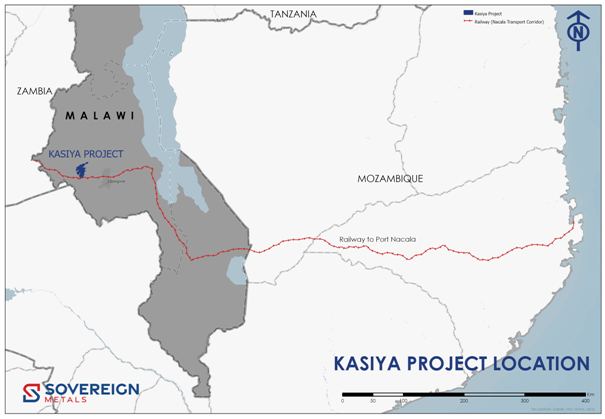Sovereign Metals: Dual-Commodity Giant Targets Battery Supply Chain

Sovereign Metals' Kasiya Project combines world's largest rutile resource with second-largest graphite deposit, backed by Rio Tinto, targeting Q4 2025 DFS completion.
- Kasiya hosts 17.9 Mt of contained rutile (world's largest) and 24.4 Mt of contained graphite (globally second-largest flake resource) across a 201 km² mineralized zone in Malawi.
- Rio Tinto's A$60M investment for a 19.9% equity stake provides blue-chip endorsement and technical committee participation through the development phase.
- January 2025 Optimised PFS shows US$2.3B pre-tax NPV8%, 27% IRR, and US$409M average annual EBITDA, with graphite production costs of US$241/t positioning below China's average.
- China's October 2025 export controls on artificial graphite anode materials create immediate demand for alternative supply sources as Western cell manufacturers seek licensing-free procurement routes.
- Completed pilot phase de-risked mining and processing assumptions; Definitive Feasibility Study due Q4 2025 marks next catalyst for financing and construction decisions.
Critical Minerals Meet Market Disruption
The battery supply chain entered a new regulatory era in October 2025 when China imposed export controls on artificial graphite anode materials, creating immediate procurement challenges for lithium-ion cell manufacturers outside China. Against this backdrop, Sovereign Metals Limited has positioned its Kasiya Project in Malawi as a rare dual-commodity development combining the world's largest rutile resource with the second-largest flake graphite resource globally. The timing proves significant: graphite remains the dominant anode material in commercial battery chemistries, while titanium feedstocks like rutile anchor industrial supply chains that could intersect with emerging battery technologies.
The March 2025 corporate presentation update emphasized graphite by-product economics at a moment when Western governments and cell manufacturers actively pursue non-Chinese graphite sources. Sovereign's development strategy differs from peers by focusing exclusively on mining rather than downstream chemical processing, reducing execution risk while targeting the bottom quartile of the global cost curve. Rio Tinto's A$60M equity investment in 2024 for a 19.9% stake provides institutional validation and technical support through the project's advancement toward a Definitive Feasibility Study (DFS) in Q4 2025.
For investors evaluating exposure to battery supply chain diversification, Kasiya represents a unique proposition: a single project delivering scale in two critical minerals, underpinned by favorable geology, completed pilot operations, and blue-chip partnership validation. The following analysis examines why this combination warrants attention from portfolios seeking leverage to structural shifts in energy storage procurement.
Company Overview: Single-Asset Focus With Dual-Commodity Leverage
Sovereign Metals operates as a pure-play development company concentrated entirely on advancing the Kasiya Project through feasibility studies toward construction decisions. The company maintains primary listings on the ASX and AIM, with OTCQX trading in the United States, providing access to capital markets across three jurisdictions. Unlike diversified miners with portfolio management complexity, Sovereign's single-asset strategy allows management focus and investor clarity around development milestones.
The geological endowment distinguishes Kasiya from conventional mining projects. The deposit contains 17.9 million tonnes of rutile and 24.4 Mt of graphite across a 201 km² mineralized area classified under JORC 2012 standards. This represents the only known deposit globally where graphite occurs as a by-product of rutile operations, creating a natural hedge against single-commodity price volatility. The flat blanket-style saprolite mineralization occurs in weathered material rather than hard rock, enabling simpler processing flowsheets and lower energy intensity compared to Northern Hemisphere graphite projects hosted in fresh rock with high sulphur content.
"Kasiya is positioned as the world's largest and lowest-cost natural graphite project, with the unique advantage of graphite being produced as a by-product of rutile mining operations. This dual-commodity model provides exceptional economics and natural price hedging that single-commodity projects cannot match."
Rio Tinto's equity participation transformed Sovereign's development profile in 2024. The A$60M investment at a 19.9% ownership level came with Rio Tinto representation on a technical committee overseeing project advancement. This partnership provides access to engineering expertise, supply chain relationships, and validation of Kasiya's technical and economic merit. For institutional investors conducting due diligence, Rio Tinto's involvement serves as third-party validation from an operator with global project development experience and rigorous internal investment criteria.
Key Development: Graphite By-Product Economics Reshape Project Value

The January 2025 Optimised Preliminary Feasibility Study (PFS) quantified Kasiya's economic potential with a pre-tax NPV8% of US$2.3B and a 27% internal rate of return. Average annual EBITDA reaches US$409M over the mine life, with first production requiring US$665M in capital expenditure. Steady-state operations target 246,000 tonnes per year of rutile concentrate and 265,000 tpy of graphite concentrate, positioning Kasiya among the world's largest producers in both commodities simultaneously.
The graphite component drives incremental margin that fundamentally alters project returns. While operating costs total US$423 per tonne on a combined basis, graphite incremental production costs reach only US$241/t below China's reported average production cost of US$257/t according to industry benchmarks. This cost positioning matters because it places Kasiya in the bottom quartile of the global cost curve, providing buffer against price volatility and ensuring production viability across market cycles. The 57% jumbo and large flake distribution commands premium pricing relative to smaller flake sizes, while very low sulphur content eliminates purification penalties that affect competing deposits.
Testwork results demonstrate Kasiya graphite meets specifications for 94% of natural graphite end-use markets, including battery anodes, refractories, expandable graphite, and lubricants. Spherical purified graphite achieved 99.99% carbon purity with excellent tap density and low BET surface area key parameters for anode performance. Unlike vertically integrated competitors pursuing downstream chemical processing, Sovereign's strategy focuses on mining operations and concentrate production, transferring downstream execution risk to offtakers while capturing margin at lower capital intensity. This approach accelerates development timelines and reduces financing complexity compared to integrated flowsheets requiring additional permitting and technology risk.
Strategic Significance: Policy Disruption Creates Non-Chinese Supply Premium
China's October 2025 announcement of export controls covering lithium-ion batteries, manufacturing equipment, and artificial graphite anode materials created immediate compliance and supply chain challenges for cell manufacturers operating outside China. The new licensing requirements add lead times and regulatory uncertainty to procurement processes, accelerating efforts by Western battery makers to secure graphite supply from jurisdictions without export restrictions. This policy shift validates multi-year trends toward supply chain regionalization that began with lithium sourcing but now extends across all battery raw materials.
Research institutions' 2025 critical minerals outlook reiterates sustained demand growth for graphite tied to energy applications, while recent analyst coverage continues focusing on synthetic versus natural graphite cost dynamics under changing policy environments. For Kasiya, these trends provide strategic tailwinds: the project offers licensing-free procurement at scale from a politically stable African jurisdiction with established mining frameworks, addressing both policy risk and ESG considerations that increasingly influence corporate procurement decisions.
Rutile's role in battery technology remains nascent compared to graphite's mainstream adoption, but titanium dioxide feedstock markets matter for project baseline economics. Recent industry announcements regarding production suspensions at major rutile operations reinforce supply tightness in industrial titanium markets. While this reflects pigment and metals demand rather than battery applications, it underscores structural supply constraints that support rutile pricing assumptions underpinning Kasiya economics. If titanium-based battery chemistries advance beyond current research phases, Sovereign holds optionality on a second battery mineral without additional exploration investment.
Current Activities: Pilot Phase De-Risks Technical Assumptions
Sovereign completed a comprehensive pilot operation covering 10 hectares and processing 170,000 cubic metres of ore through full mining, processing, deposition, and rehabilitation sequences. This pilot phase validated key technical assumptions regarding ore handling characteristics, processing flowsheet performance, concentrate quality, and environmental management. Unlike desktop studies relying on laboratory testwork, the pilot operation demonstrated commercial-scale processes under field conditions, reducing technical risk for subsequent engineering phases.
The DFS scheduled for Q4 2025 represents the next major milestone in Kasiya's development pathway. This study will refine capital and operating cost estimates, finalize mine design and processing configurations, complete environmental and social impact assessments, and establish the definitive economic case for project financing. Rio Tinto's technical committee participation ensures rigorous engineering standards and integration of best practices from comparable large-scale mining developments. Completion of the DFS positions Sovereign to engage project financiers, strategic offtakers, and construction contractors with bankable documentation.
Geological advantages embedded in Kasiya's deposit characteristics continue providing competitive differentiation throughout engineering refinement. The soft weathered saprolite requires no blasting and minimal comminution compared to hard rock deposits, reducing energy consumption and equipment wear rates. Very low sulphur content eliminates acid generation risks and purification processing stages that add cost and environmental complexity to competing graphite projects in Northern Hemisphere jurisdictions. The flat blanket geometry enables conventional open-pit mining with low strip ratios and predictable grade control, supporting high asset utilization and steady production rates across the mine life.
The Investment Thesis for Sovereign Metals
- China's October 2025 export controls create structural demand for non-Chinese graphite sources as Western cell manufacturers secure licensing-free procurement routes at scale.
- Combined rutile and graphite production provides natural hedge against single-commodity price volatility while capturing margin uplift from graphite by-product economics at incremental cost.
- Rio Tinto's A$60M equity investment and technical committee participation de-risks development execution while providing institutional endorsement for project quality and management capability.
- US$241/t incremental graphite production cost below China's US$257/t average places Kasiya in bottom quartile globally, ensuring margin sustainability across commodity cycles.
- Definitive Feasibility Study completion provides next major re-rating opportunity as project transitions from technical validation to financing and construction decision phases.
- 265,000 tpy graphite and 246,000 tpy rutile steady-state production positions Kasiya among world's largest producers in both commodities from single development.
The intersection of favorable project fundamentals and disruptive policy changes creates a compelling entry point for investors evaluating battery supply chain exposure. Sovereign Metals offers a pure-play vehicle on dual-commodity development at world-class scale, with completed pilot operations de-risking technical execution and Rio Tinto partnership validating project quality. The US$2.3B pre-tax NPV8% from the January 2025 Optimised PFS translates to substantial value creation potential relative to current market capitalization, particularly as Q4 2025 DFS completion approaches.
For portfolio construction purposes, Sovereign provides differentiated exposure within the battery materials sector. Unlike lithium-focused peers facing oversupply concerns and price volatility, or rare earth developers navigating complex processing challenges, Kasiya combines established mining methods with favorable geology and proven processing flowsheets. The dual-commodity nature hedges single-material exposure while the Rio Tinto partnership provides credibility with institutional allocators conducting ESG and technical due diligence. Investors seeking leverage to battery supply chain regionalization trends should monitor Q4 2025 DFS results as the next major catalyst for valuation reassessment.
Analyst's Notes




Subscribe to Our Channel
Stay Informed


















